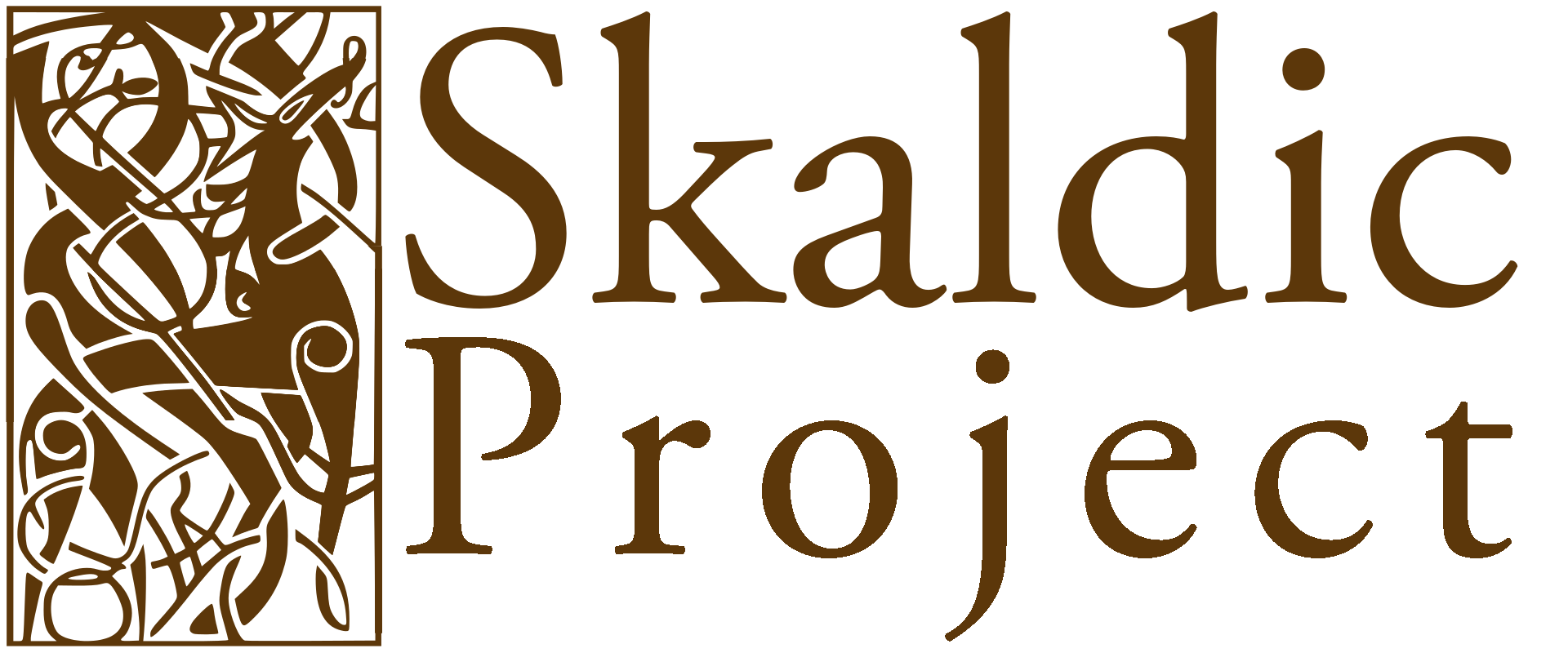Anon Sól 50VII
Carolyne Larrington and Peter Robinson (eds) 2007, ‘Anonymous Poems, Sólarljóð 50’ in Margaret Clunies Ross (ed.), Poetry on Christian Subjects. Skaldic Poetry of the Scandinavian Middle Ages 7. Turnhout: Brepols, pp. 330-1.
Hörundar ‘of the flesh’
(not checked:)
1. hǫrund (noun f.; °-ar): [flesh]
hungr ‘The hunger’
(not checked:)
1. hungr (noun m.; °hungrs/-s, dat. hungri, acc. hungr/hung): hunger
tælir ‘entraps’
(not checked:)
tæla (verb): entice
hölða ‘men’
(not checked:)
hǫlðr (noun m.; °-s; -ar): man
opt ‘often’
(not checked:)
opt (adv.): often
hann ‘’
(not checked:)
hann (pron.; °gen. hans, dat. honum; f. hon, gen. hennar, acc. hana): he, she, it, they, them...
[3] hann: þann 1441ˣ
hefr ‘possesses’
(not checked:)
hafa (verb): have
margr ‘many’
(not checked:)
2. margr (adj.; °-an): many
til ‘in’
(not checked:)
til (prep.): to
langa ‘’
(not checked:)
langr (adj.; °compar. lengri, superl. lengstr): long
lauga ‘washing’
(not checked:)
laug (noun f.; °-ar; dat. -u/-; -ar): bath, hot spring < Laugavatn (noun n.)
[4] lauga‑: langa 738ˣ, 1441ˣ
notes
[4] laugavatn ‘A bath, washing water’: The significance of this reference is unclear. Some eds assume that the water symbolises repentance and absolution, cf. the heavenly maidens of st. 74 who wash souls clean. Falk (1914a, 29), following CVC: laug, makes the connection with the Saturday (laugardagr) bath, as physical and spiritual preparation for Sunday. Björn M. Ólsen (1915, 46; also Paasche 1948, 183) suggests the bath represents the hot tears of remorse and penitence; cf. Njörður Njarðvík (1991, 79). Njörður Njarðvík (1991, 197-8) contributes a parallel from the Dialogues of Gregory, referring to washing as a way of removing sin produced by intercourse with women (Unger 1877, I, 246). If water symbolises spiritual cleansing here, then the narrator presumably alludes to his former life of debauchery when he was not yet ready to undergo penance. Earlier commentators, as Fidjestøl (1979, 47-8) notes, regarded the bath as the kind of luxury which the body now no longer requires.
vatn ‘water’
(not checked:)
vatn (noun n.; °-s; -*): water, lake < Laugavatn (noun n.)
notes
[4] laugavatn ‘A bath, washing water’: The significance of this reference is unclear. Some eds assume that the water symbolises repentance and absolution, cf. the heavenly maidens of st. 74 who wash souls clean. Falk (1914a, 29), following CVC: laug, makes the connection with the Saturday (laugardagr) bath, as physical and spiritual preparation for Sunday. Björn M. Ólsen (1915, 46; also Paasche 1948, 183) suggests the bath represents the hot tears of remorse and penitence; cf. Njörður Njarðvík (1991, 79). Njörður Njarðvík (1991, 197-8) contributes a parallel from the Dialogues of Gregory, referring to washing as a way of removing sin produced by intercourse with women (Unger 1877, I, 246). If water symbolises spiritual cleansing here, then the narrator presumably alludes to his former life of debauchery when he was not yet ready to undergo penance. Earlier commentators, as Fidjestøl (1979, 47-8) notes, regarded the bath as the kind of luxury which the body now no longer requires.
er ‘’
(not checked:)
2. er (conj.): who, which, when
eitt ‘’
(not checked:)
2. einn (pron.; °decl. cf. einn num.): one, alone
mér ‘to me’
(not checked:)
ek (pron.; °mín, dat. mér, acc. mik): I, me
[5] mér: so papp15ˣ, eitt er mér 166bˣ, er mér 738ˣ, 214ˣ, 1441ˣ, 10575ˣ, 2797ˣ
notes
[5] mér ‘to me’: Er ‘which’ appears in the majority of mss before mér but makes the last half of the st. ungrammatical, unless laugavatn is construed as in apposition to hörundar hungr (l. 1). Skj B omits it, though Falk, Skald, Björn M. Ólsen and Njörður Njarðvík 1991 do not.
leiðast ‘most hateful’
(not checked:)
2. leiðr (adj.; °compar. -ari, superl. -astr): hateful, loathsome
[5] leiðast: leiðist 214ˣ
varð ‘’
(not checked:)
1. verða (verb): become, be
var ‘was’
(not checked:)
2. vera (verb): be, is, was, were, are, am
[5] var: varð papp15ˣ, 738ˣ, 214ˣ, 1441ˣ
eitt ‘alone’
(not checked:)
2. einn (pron.; °decl. cf. einn num.): one, alone
allra ‘of all’
(not checked:)
allr (adj.): all
hluta ‘things’
(not checked:)
hlutr (noun m.; °-ar, dat. -i/-; -ir, acc. -i/-u): part, thing
Interactive view: tap on words in the text for notes and glosses
Stanza/chapter/text segment
Use the buttons at the top of the page to navigate between stanzas in a poem.
Information tab
- text: if the stanza has been published, the edited text of the stanza and translation are here; if it hasn't been published an old edition (usually Skj) is given for reference
- sources: a list of the manuscripts or inscriptions containing this stanza, with page and line references and links (eye button) to images where available, and transcription where available
- readings: a list of variant manuscript readings of words in the main text
- editions and texts: a list of editions of the stanza with links to the bibliography; and a list of prose works in which the stanza occurs, allowing you to navigate within the prose context
- notes and context: notes not linked to individual words are given here, along with the account of the prose context for the stanza, where relevant
Interactive tab
The text and translation are given here, with buttons to toggle whether the text is shown in the verse order or prose word order. Clicking on indiviudal words gives dictionary links, variant readings, kennings and notes, where relevant.
Full text tab
This is the text of the edition in a similar format to how the edition appears in the printed volumes.
Chapter/text segment
This view is also used for chapters and other text segments. Not all the headings shown are relevant to such sections.
